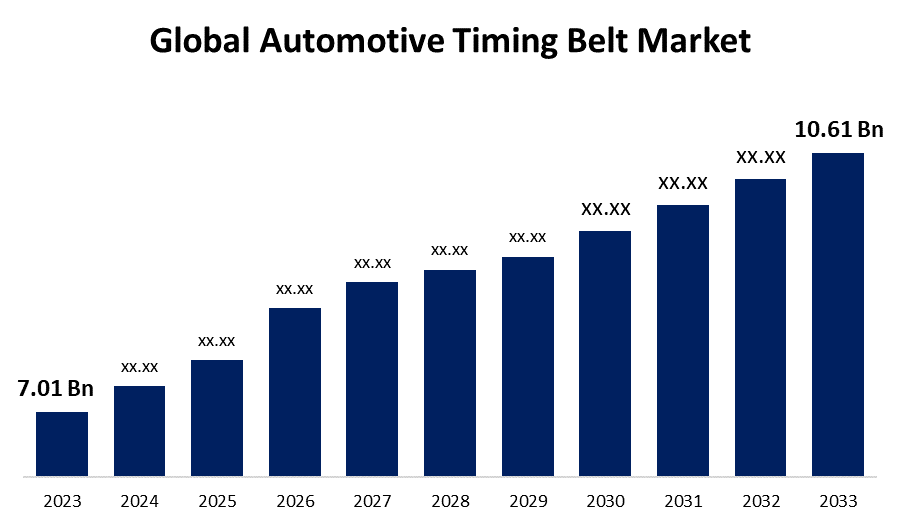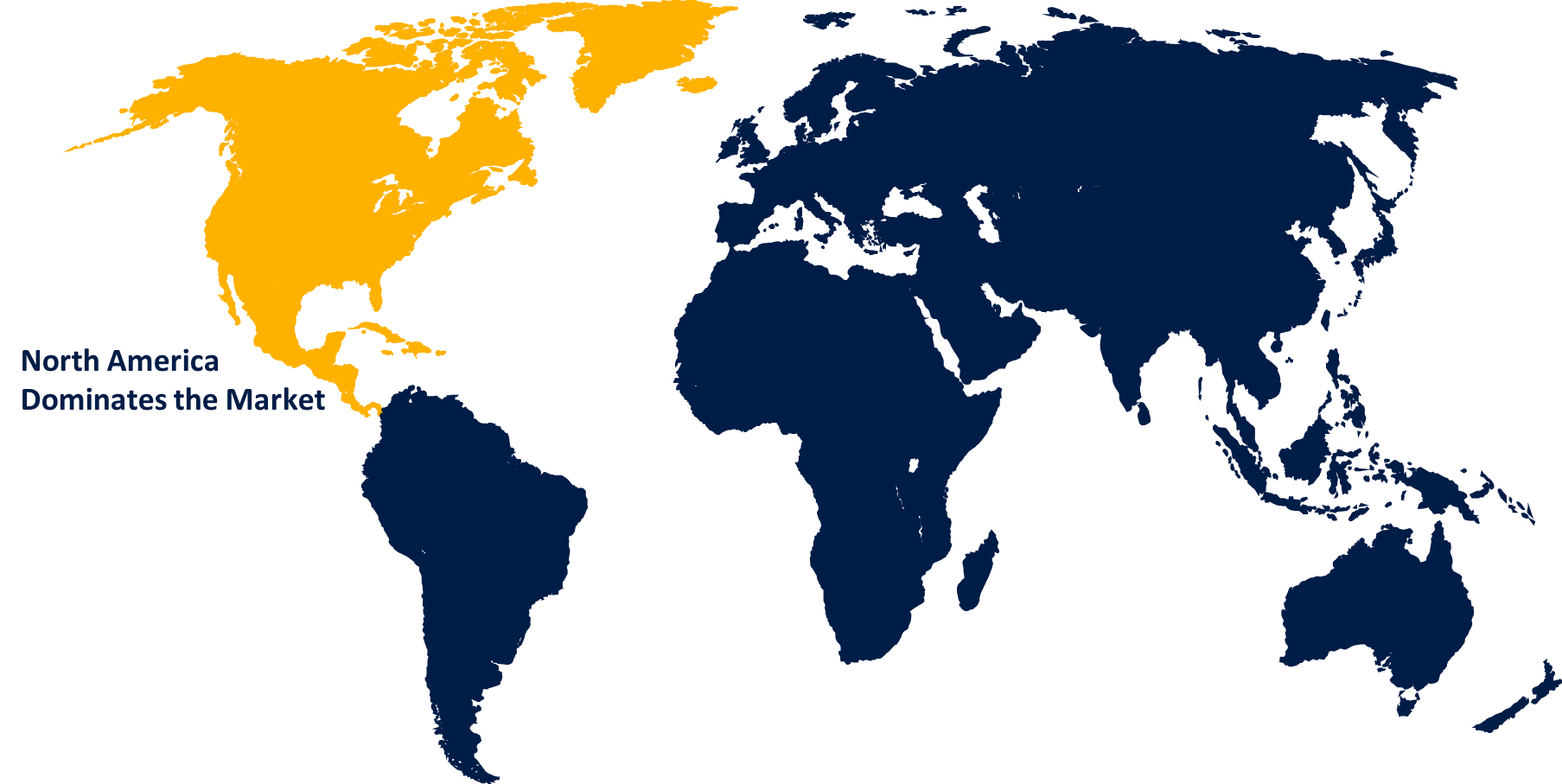Global Automotive Timing Belt Market Size, Share, and COVID-19 Impact Analysis, By Type (Belt-In-Oil, Chains, and Dry Belts), By Vehicle Type (Passenger Vehicles, Light Commercial Vehicles, and Heavy Commercial Vehicles) By Distribution Channel (OEM and Aftermarket), and By Region (North America, Europe, Asia-Pacific, Latin America, Middle East, and Africa), Analysis and Forecast 2023 - 2033
Industry: Automotive & TransportationGlobal Automotive Timing Belt Market Insights Forecasts to 2033
- The Global Automotive Timing Belt Market Size was Valued at USD 7.01 Billion in 2023
- The Market Size is Growing at a CAGR of 4.23% from 2023 to 2033
- The Worldwide Automotive Timing Belt Market Size is Expected to Reach USD 10.61 Billion by 2033
- Europe is Expected to Grow the fastest during the forecast period.

Get more details on this report -
The Automotive Timing Belt Market Size is Anticipated to Exceed USD 10.61 Billion by 2033, Growing at a CAGR 4.23% from 2023 to 2033.
Market Overview
An automotive timing belt drives the valves opening and closing of an engine by connecting the crankshaft and camshaft of a vehicle, such as an automobile. The automotive timing belt, often known as the cambelt, in a car, is crucial to the operation of internal combustion engines. Timing belts are made of high-quality rubber with nylon-reinforced strands to extend their life. The timing belt's function is to synchronize the rotation of the crankshaft and camshaft when this is done, your car's pistons and valves will function as intended. In some situations, the timing belt passes directly through the oil. Manufacturers apply this design to reduce friction in the engine and hence lower emissions. At the same time, this assures low-noise operation and exact timing. However, operating in this manner causes significant strain on the timing belt's wear qualities. Because even trace contaminants in the oil can cause crystals to develop. If such crystals become trapped between the belt and the pulley, the belt may be damaged or, in the worst-case scenario, it may rupture. The automotive timing belt market has experienced rapid growth and innovation, owing to a variety of causes. Rising new vehicle sales, combined with rising demand from the replacement market, are predicted to drive worldwide timing belt demand. The growing global production and sales of passenger automobiles, commercial vehicles, and light trucks have increased demand for timing belts, which are critical components of internal combustion engines. Timing belt manufacturers and distributors can benefit from the expanding automotive aftermarket industry, which is being pushed by increased e-commerce platforms and a growing vehicle fleet.
Automotive Timing Belt Features
- The high-modulus fiberglass cord provides accurate length stability for smoother runs over the life of the belt.
- Built with a double-layered nylon tooth fabric covering for increased flexibility and heat resistance.
- Provides constant slip-proof power transfer with exceptional resistance to oil and engine heat.
- Formulated HSN compounds withstand heat build-up for longer, increasing total belt longevity.
Report Coverage
This research report categorizes the market for the automotive timing belt market based on various segments and regions forecasts revenue growth and analyzes trends in each submarket. The report analyses the key growth drivers, opportunities, and challenges influencing the automotive timing belt market. Recent market developments and competitive strategies such as expansion, product launch, and development, partnership, merger, and acquisition have been included to draw the competitive landscape in the market. The report strategically identifies and profiles the key market players and analyses their core competencies in each sub-segment of the automotive timing belt market.
Automotive Timing Belt Market Report Coverage
| Report Coverage | Details |
|---|---|
| Base Year: | 2023 |
| Market Size in 2023: | USD 7.01 Billion |
| Forecast Period: | 2023 - 2033 |
| Forecast Period CAGR 2023 - 2033 : | 4.23% |
| 2033 Value Projection: | USD 10.61 Billion |
| Historical Data for: | 2019-2022 |
| No. of Pages: | 253 |
| Tables, Charts & Figures: | 110 |
| Segments covered: | By Type, By Vehicle Type, By Distribution Channel , By Region |
| Companies covered:: | AISIN CORP., Bando Chemical Industries Ltd., BorgWarner Inc., BRECOflex Co L.L.C., Continental AG, Dayco IP Holdings LLC, Daido Kogyo Co. Ltd, SKF AB, Iwis Group, Gates Corporation, B&B Manufacturing, Carlstar Group, Mitsuboshi Belting Ltd., Ningbo Fulong Synchronous Belt Co., Ltd, and Others |
| Pitfalls & Challenges: | Covid 19 Impact Challanges, Future, Growth and Analysis |
Get more details on this report -
Driving Factors
Timing belts are an essential component of internal combustion engines; therefore expansion in the automobile industry has a direct impact on demand for products. A worldwide rise in vehicle production and sales is driving the automotive timing belt industry. Furthermore, timing belt demand is rising as the vehicle industry in emerging countries increases. Furthermore, consumers' preference for high-mileage vehicles has led to an increase in timing belt demand over time.
Restraining Factors
The demand for timing belts and other traditional internal combustion engine parts may decrease as the desire for pure battery electric vehicles has restricted the growth of the timing belt market. However, the availability of replacement components such as timing chains restricts the overall timing belt market.
Market Segmentation
The automotive timing belt market share is classified into type, vehicle type, and distribution channel.
- The belt-in-oil segment accounted for the largest revenue share over the forecast period.
Based on the type, the automotive timing belt market is categorized into belt-in-oil, chains, and dry belts. Among these, the belt-in-oil segment accounted for the largest revenue share over the forecast period. The timing belt-in-oil has more powerful oil and heat resistance than ordinary rubber belts and works inside the engine block (oil environment) where oil sticks and rubber belts were previously accessible.
- The passenger vehicles segment is anticipated to grow at the highest CAGR during the forecast period.
Based on the vehicle type, the automotive timing belt market is categorized into passenger vehicles, light commercial vehicles, and heavy commercial vehicles. Among these, the passenger vehicles segment is anticipated to grow at the highest CAGR during the forecast period. Passenger vehicles include sedans, hatchbacks, SUVs, and minivans. Timing belts in passenger vehicles are crucial to ensure exact synchronization of engine components, allowing for superior performance, fuel efficiency, and emissions management.
- The OEM segment dominates the market with the highest market share through the forecast period.
Based on the distribution channel, the automotive timing belt market is categorized into OEM and aftermarket. Among these, the OEM segment dominates the market with the highest market share through the forecast period. OEMs play an important role in generating demand for timing belts since they set the specifications, standards, and sourcing decisions for the components used in their cars. The OMEs market is significant due to the large volume of new vehicle manufacturing worldwide, where timing chains and belts are critical components for engine operation and durability.
Regional Segment Analysis of the Automotive Timing Belt Market
- North America (U.S., Canada, Mexico)
- Europe (Germany, France, U.K., Italy, Spain, Rest of Europe)
- Asia-Pacific (China, Japan, India, Rest of APAC)
- South America (Brazil and the Rest of South America)
- The Middle East and Africa (UAE, South Africa, Rest of MEA)
North America is anticipated to hold the largest share of the automotive timing belt market over the predicted timeframe.

Get more details on this report -
North America is projected to hold the largest share of the automotive timing belt market over the forecast period. This can be attributed to a well-established automotive sector, elevated rates of vehicle ownership, and robust demand for spare parts. Due in large part to the large number of vehicles in North America that required timing belt replacement and maintenance, as well as the robust aftermarket ecosystem that supported the selling of automotive components, the region's market share increased. Significant automakers and suppliers were also advantageous to North America, as they aided in fostering a competitive market for timing belts and related products.
Europe is expected to grow at the fastest CAGR growth in the automotive timing belt market during the forecast period. This is because of its sizable automobile market, stringent quality requirements, and focus on auto maintenance and repair. European consumers consistently place a high value on vehicle performance and dependability, which drives the demand for high-quality timing belts and related parts. Furthermore, there is a greater need for timing belt systems that support fuel-saving strategies and adhere to emissions regulations due to Europe's emphasis on sustainability and environmental consciousness.
Asia Pacific region is witnessing significant growth in the automotive timing belt market. Asia Pacific is the most essential market for automotive timing cover providers due to the region's expanding automobile manufacturing. Rising technology advances, rising vehicle sales, and rising need for better timing covers are all contributing to regional market expansion. Timing belts were in high demand in China, India, and Japan, owing to increased production and sales of passenger cars, commercial vehicles, and light trucks. Furthermore, Asia-Pacific's market share was boosted by the availability of a large consumer base, supportive government regulations, and investments in automotive manufacturing infrastructure.
Competitive Analysis:
The report offers the appropriate analysis of the key organizations/companies involved within the automotive timing belt market along with a comparative evaluation primarily based on their product offering, business overviews, geographic presence, enterprise strategies, segment market share, and SWOT analysis. The report also provides an elaborative analysis focusing on the current news and developments of the companies, which includes product development, innovations, joint ventures, partnerships, mergers & acquisitions, strategic alliances, and others. This allows for the evaluation of the overall competition within the market.
List of Key Companies
- AISIN CORP.
- Bando Chemical Industries Ltd.
- BorgWarner Inc.
- BRECOflex Co L.L.C.
- Continental AG
- Dayco IP Holdings LLC
- Daido Kogyo Co. Ltd
- SKF AB
- Iwis Group
- Gates Corporation
- B&B Manufacturing
- Carlstar Group
- Mitsuboshi Belting Ltd.
- Ningbo Fulong Synchronous Belt Co., Ltd
- Others
Key Target Audience
- Market Players
- Investors
- End-users
- Government Authorities
- Consulting And Research Firm
- Venture capitalists
- Value-Added Resellers (VARs)
Recent Developments
- In February 2024, Cloyes Gear & Products, Inc., a global manufacturer and designer of mission-critical timing drive systems and components for the automotive aftermarket, declared the acquisition of Automotive Tensioners, Inc., a leading supplier of front-end accessory drive pulling chains and tensioners to the automotive market.
- In December 2023, Dayco, a top provider of engine parts and drive systems to the auto, industrial, and aftermarket sectors, revealed that Tony Stewart Racing (TSR) has agreed to utilize Dayco's blower belts once more in the 2024 NHRA Mission Foods Drag Racing Series, following their successful collaboration in 2023. On the track, Dayco blower belts will be used by NASCAR, INDYCAR, and USAC champion Tony Stewart, and four-time Funny Car champion Matt Hagan.
Market Segment
This study forecasts revenue at global, regional, and country levels from 2020 to 2033. Spherical Insights has segmented the automotive timing belt market based on the below-mentioned segments:
Global Automotive Timing Belt Market, By Type
- Belt-In-Oil
- Chains
- Dry Belts
Global Automotive Timing Belt Market, By Vehicle Type
- Passenger Vehicles
- Light Commercial Vehicles
- Heavy Commercial Vehicles
Global Automotive Timing Belt Market, By Distribution Channel
- OEM
- Aftermarket
Global Automotive Timing Belt Market, By Regional Analysis
- North America
- US
- Canada
- Mexico
- Europe
- Germany
- UK
- France
- Italy
- Spain
- Russia
- Rest of Europe
- Asia Pacific
- China
- Japan
- India
- South Korea
- Australia
- Rest of Asia Pacific
- South America
- Brazil
- Argentina
- Rest of South America
- Middle East & Africa
- UAE
- Saudi Arabia
- Qatar
- South Africa
- Rest of the Middle East & Africa
Need help to buy this report?